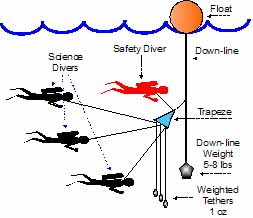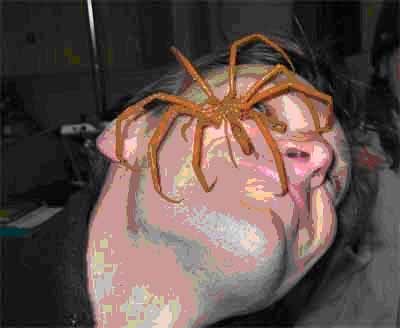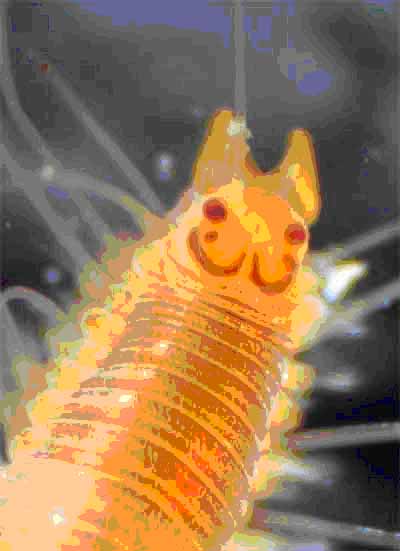[Wind: NE 23kn / Air Temp: 0.3C / Wind Chill: -15.8C /Water Depth: 195 meters, lt. snow all day]
| • Home |
| • Questions |
| • Participants |
| • Background Information |
The Blake trawl at noon yielded more stuff than we could process in our 4 hours! Just to give you a window on what happens once the nets are emptied on deck,

| 1 | 2 | 3 | 4 | 5 | 6 | |
| 7 | 8 | 9 | 10 | 11 | 12 | 13 |
| 14 | 15 | 16 | 17 | 18 | 19 | 20 |
| 21 | 22 | 23 | 24 | 25 | 26 | 27 |
| 28 | 29 | 30 |
| 1 | 2 | 3 | 4 | |||
| 5 | 6 | 7 | 8 | 9 | 10 | 11 |
| 12 | 13 | 14 | 15 | 16 | 17 | 18 |
| 19 | 20 | 21 | 22 | 23 | 24 | 25 |
| 26 | 27 | 28 | 29 | 30 | 31 |
we first dive in and say “OOH!!” and “AAAH!!” and pick up all of the ‘cool stuff’ we can see on the top of the heap (huge stars, fish, octopods, scale worms, etc.).
Then we each take a position around the pile and do a gross sort, pulling out the big items and putting them into large buckets (like the kinds painters use) with seawater to keep them “fresh” or alive for a later view (and perhaps return to the sea). When the pile starts looking ragged, a couple of people start putting shovelfuls of the stuff onto the sorting table, and I’ve told you all this before, right? Well, once the critters are rough sorted on deck, we take them into the Wet Lab and sort them onto large white trays (like cafeteria trays), by “family” (starfish on one, sea cucumbers and other squishy things on another, mollusks on another, etc.) and smaller containers for our little friends. The fine sorting comes next, with the up to 20 or so best specimens from each group, where the best looking one is numbered, photographed and… sliced. (Some critter families have individuals that look very much the same, but actually are not the same species, and that has to be determined under a microscope. It’s all very scientific, and well it should be, right?) This “slicing” part means two samples of the critter’s body are taken (depending on the animal, but let’s use the sea star for example), like the tip of one leg, plus the next 1-inch piece up from it, and those pieces go into vials. One vial is frozen dry, the other is filled with alcohol, and the main body goes into a large vial filled with formaldehyde (this is the voucher). Then, one piece is taken from each of the other samples from that family, and given similar numbers to the original, only in a counting sequence that separates each specimen, and those pieces are deep frozen along with the original voucher piece. All of these samples are listed by number in a log book, which is later put into an electronic database. This procedure is repeated again and again, each time there is a bottom trawl. We are halfway through the cruise, and the freezers and other bins are really starting to fill up. When it all goes back to the scientist’s ‘home base’, several things may happen to the, such as being analyzed for factors relative to their DNA (to precisely identify the organism), to help document what is living down here, and in the case of the collaboration with Dr. Scheltema, which larva belongs to which adult. There could be several years’ worth of research for many people to follow up this collection!
Jeff Godfrey is the Diving Safety Officer (DSO) on this cruise. His job is very specific – to be sure that the divers have the qualification and equipment to participate in the dives, and to be sure that every diver who goes out returns safely. Jeff describes his job in the following text: “My job as the Diving Safety Officer is to ensure that diving operations are conducted in a safe and efficient manner so that the scientists can meet their research objectives. The planning for dive operations for this cruise started several months ago. Divers have to be qualified to dive in Antarctica. So choosing the correct people for the dive team is very important. Not only do the divers have to pass a physical before they are approved to dive, they have to meet training and proficiency requirements. At a minimum, divers have to be certified as scientific divers and have drysuit diving experience and blue water diving experience. Drysuits are required for diving in the cold waters of Antarctica because they keep the divers warmer then the wetsuits that divers normally wear. Hypothermia (low body temperature) is an important consideration when diving because water conducts heat away from your body 25 times faster than air. Getting in the water in Antarctica without a suit would be like standing around in your underwear in –68o F weather. You wouldn’t live long [ed. note: and you wouldn’t want to die in your underwear!]. Bluewater diving refers to special techniques that we use because we are diving in the open ocean where the bottom is several hundred feet below and it is very easy to get separated from the dive team and get lost at sea. In bluewater diving we use a trapeze, which is a system of clips and weights and lines to keep all the divers tethered to a safety diver. It is the safety diver’s job to monitor the divers and provide assistance in case of an emergency. I act as the ‘safety diver’. This frees up the scientists to concentrate on collecting the animals they need for their research.
Because the bottom is several hundred or even thousands of feet below, if you drop anything, it's gone for good. So divers must securely attach all of their equipment to themselves.
The equipment that bluewater divers generally use includes catch bags, jars, pencils, and cameras. The reason we dive on this trip is to collect gelatinous zooplankton - like jelly fish. If you try to use a net to collect gelatinous zooplankton, you kill it. Divers however can capture the zooplankton in jars and bring them back to the research vessel in perfect condition to study them. Divers can also use video and still cameras to take pictures of the animals in their natural habitat for further study. Divers use net catch bags to keep the jars in, and grease pencils to write important information on the lids of the jars.
Most of my time between dives is spent filling SCUBA tanks, coiling the tethers and down line, fixing equipment and helping wherever else I'm needed."
Jeff fits right into the scheme of things, takes an interest in all of the science at hand, and we are glad to have him as part of the crew.

Photo3

Because it is still light (dusk-like), and the fact that salps tend to be more abundant at the top of the water column in the later hours of the day, the divers have been going out at midnight with great collection success! We hope to have a dive as part of the exploration at Deception Island. Now you know what the routine of that, as well as all of the dives to retrieve salps, entails. (By the way, have you all gone to the Uconn/Antarctica website to learn what salps are? www.marinesciences.uconn.edu/rvgould)
Cat-ches of the Day: See the Images and see for yourself!
Dinner Menu (shipboard, 12/6): |
|
TBD |